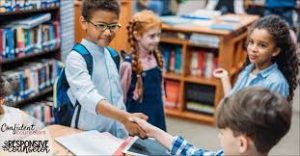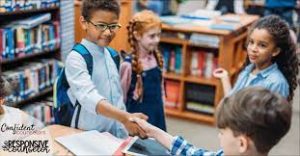Student Contributor: J. Valenzuela
 When an altercation occurs, the teacher initiates conflict resolution, helping guide students to follow three key steps: Listen, Explore, Review.
When an altercation occurs, the teacher initiates conflict resolution, helping guide students to follow three key steps: Listen, Explore, Review.
When a conflict arises between two students, action must be taken. As the teacher, it is our job to facilitate a resolution to that conflict. We bring the students together, at a table away from the other students. We ask the rest of the students to read quietly, or work on their reading and math practices on their chrome books until the dispute is resolved. We navigate the entire class this way because we want to make it a point to all students that their state of mind is important and that the entire class’ energy gets thrown off when two of it’s members are at odds with one another. As we start our resolution, we ask each student to respect the other when they are speaking and to not interrupt. We begin by asking each student to explain what happened in their own words and in their own experience. Once both sides have communicated what has happened, we prompt students to explore ways in which we can solve the disagreement/dispute. Once we have a common dispute solution agreement, the teacher prompts students to review what has happened to each of them, each taking turns, and each reiterating to one another their common dispute solution agreement. Completing the triad of listen, explore and review.
 Resolute Resolution is a corrective phase tool. It requires students, with guidance from the teacher, to resolve a behavior either during its apex, or just before it becomes a problem. This is a student directed & collaborative method because, as it may be facilitated by the teacher, the students are the ones talking about how they feel and what they can do together to resolve the issue. It gives each student in the conflict the sense that they are in control of how their emotions develop and a sense of comradery with their peers because they know, if this tool is implemented regularly, that there is an avenue for peace and resolve. In a classroom where students can expect to respectfully disagree and solve their problems on their own as the last course of action for a dispute, they can feel comfortable expressing themselves, preventing issues from arising because they are not confined to consequence or judgement. This tool allows for students to feel that they are in control of their emotions and how the class feels to everybody, and the students gain a sense of cohesion to the room in its entirety and how the energy flows within it, thus supporting the students as a group and as individuals.
Resolute Resolution is a corrective phase tool. It requires students, with guidance from the teacher, to resolve a behavior either during its apex, or just before it becomes a problem. This is a student directed & collaborative method because, as it may be facilitated by the teacher, the students are the ones talking about how they feel and what they can do together to resolve the issue. It gives each student in the conflict the sense that they are in control of how their emotions develop and a sense of comradery with their peers because they know, if this tool is implemented regularly, that there is an avenue for peace and resolve. In a classroom where students can expect to respectfully disagree and solve their problems on their own as the last course of action for a dispute, they can feel comfortable expressing themselves, preventing issues from arising because they are not confined to consequence or judgement. This tool allows for students to feel that they are in control of their emotions and how the class feels to everybody, and the students gain a sense of cohesion to the room in its entirety and how the energy flows within it, thus supporting the students as a group and as individuals.
More Information –
Tool Source: Rick Harris, West Central Community Center



I used this management tool in a suburban kindergarten classroom of about 18 students. Early on I noticed that conflicts in the classroom happened often and caused meltdowns between the students. Overall, I feel like I had to repeatedly at the start discuss the process of this to the students when a conflict has come up. Along with this at the start I had to monitor the student’s discussions and lead them in how they can solve the problem. As we progressed more the students started using this tool less and less because they were beginning to solve the problem on their own. Looking back, I strongly feel like the students understood their role and what needs to be done. The students felt as well that they were making a positive impact in the classroom and were able to control their own emotions. Through this tool it did not disrupt much of our classroom time and built a strong positive classroom community.